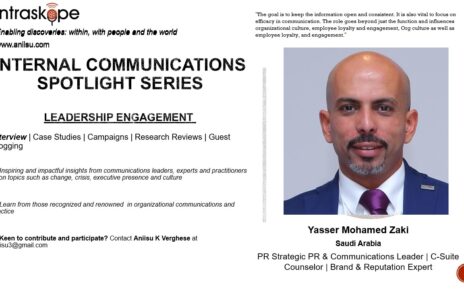In a recent interaction with communicators, one participant asked if we noticed any new trends with CEO communication. It seemed like how CEOs communicate, the actions they take and what they expect from communication determined which direction their business progressed. We don’t need to look far to notice the state of one of the world’s biggest ride hailing companies and the role of their leader’s communication that resulted in his ouster and the drop in credibility among staff and stakeholders. I looked up research studies and reports related to CEOs and how they engage and here are a few reasons that can help leaders view the influence of communication in a whole new light.
– About 45% of a company’s reputation and 44% of a company’s market value is attributable to the reputation of the CEO, and the link between CEO and corporate reputation isn’t dissipating. This despite reports indicating that trust is eroding and peers are more trusted than leaders. Interestingly, when executives were asked about the drivers of company’s overall reputation, both the leader’s reputation and marketing and communication effort were on an even keel at 49%. The push towards managing the brand, marketing and communication are seen to be increasing with 48% of CEOs making major changes. 50% of CEOs believe social media communication and engagement will give the best bang for the buck among the connecting technologies available.
– Humility is the new currency for leaders although just 2 out of 10 senior executives believed their CEOs were humble. Humble CEOs were competent communicators, performed better than the rest in terms of motivating staff, were comfortable talking to the news media and were open and accessible. It also appeared as a differentiating trait among best-performing CEOs vis-à-vis other CEOs – less narcissist and more focused on the values and efficiency.
– It is heartening to see that a majority of CEOs believe corporate communications to be important and strategic in making business plans come alive, reduce risks and build a brand. Furthermore, internal communication is viewed as essential to the success of external communication and positioning of organizations. There are acknowledgments and calls to change how communication is practiced considering the current generation is all about social while the previous one related to e-mail. Leaders are expected to listen more and then act with focus.
– Leaders believe that effective communication leads to improved chances of buy-in from the constituencies that execute strategies and communications are viewed as an integral and active component of the strategic planning and execution process. Having a clear plan around CEO engagement can lead to a better connection with stakeholders, within and outside the organization. The top three tips for CEOs to build trust is to communicate clearly and transparently, share truthfully and engage employees on the state of the business.
– What do leaders expect most of their employees? Collaboration is most important expectation CEOs have of their employees, with 75% believing it to be non-negotiable. CEOs are increasingly focused on finding employees with the ability to constantly reinvent themselves – those who are comfortable with change; learn as they go and often from others’ experiences.
There are opportunities for communicators to get their CEOs to tap the power of communication even more.
While many communicators attempt positioning their CEOs it isn’t an easy task with localizing strategies taking precedence over a uniform approach. Likewise, very few follow an institutionalized or a management process while pitching their leaders, an opportunity for communicators.
To begin, helping leaders contribute to thought leadership content can add value to the brand. In a study among Canadian CEOs, only one in five of all posts offered ‘thought leadership’ qualities, such as visions or opinions on the state of the CEO’s industry. Improving this can work well for the leader and the organization.
Leaders struggle with making sense of complex situations and simplifying it for stakeholders is where communicators can step in. Also, they seem to be wary of engaging on social media due to risks related to message control and information leakages. Few CEOs have a good sense of privacy settings on social media platformswhich are risks that companies and communicators can overcome through training and coaching.
Overall, knowing what makes CEO communication tick can allow communicators to rewire their interventions and be valued as strategic advisors.
This article first appeared on my Linkedin page.
If you found this article useful, do follow me on Linkedin and subscribe to my blog at www.aniisu.com or www.intraskope.wordpress.com



